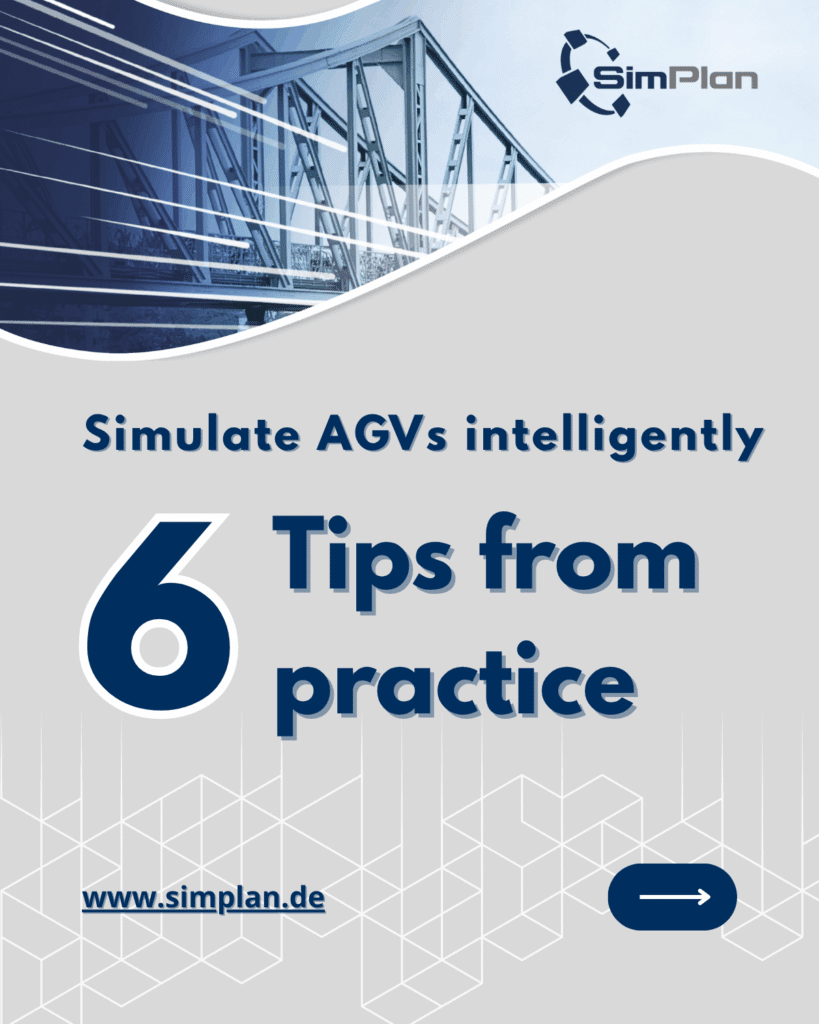How to plan and simulate AGV projects realistically, efficiently and future-proof
Automated guided vehicle systems (AGVs) are an important part of modern intralogistics today. For a simulation project to deliver reliable results, you need more than just software – you need clear goals, solid data and well-thought-out planning.
Here are six proven tips from practice.
1. Define system parameters and vehicle behaviour precisely
A simulation is only as realistic as the parameters on which it is based. For AGV systems, these include transport volumes, order types, operating times, route layout and vehicle characteristics such as speed, acceleration, braking behaviour and battery management.
The more accurately these values are recorded, the more reliable the simulation results will be. Inaccurate assumptions often lead to incorrect investment decisions or unrealistic performance forecasts.
2. Clearly define control logic and decision criteria
AGVs do not move randomly through the warehouse; they follow a control logic. This must be mapped in the simulation: priorities, traffic rules, order sequences, and detour strategies in the event of blockages.
Equally important: define before the project starts which decisions you want to make with the simulation. Is it about the number of vehicles? The optimisation of routes? The evaluation of alternative layouts? A clear definition of objectives makes the evaluation targeted and meaningful.
3. Start early with solid data
Simulation is most useful when it is used early in the planning phase rather than at the end of the project – ideally before investment decisions are made.
The data basis is crucial: incomplete or outdated data distorts results and can lead to incorrect conclusions. Allow sufficient time for data collection and preparation, or work closely with partners who can provide support in this area.
4. Promote interdisciplinary collaboration
AGV simulation does not only affect one department. Planning, production, logistics, IT and maintenance each contribute important perspectives – from process understanding and technical conditions to operational experience.
An interdisciplinary team ensures that the model takes all relevant influencing factors into account and remains practical. At the same time, it increases acceptance of the results among all those involved.
5. Secure long-term benefits
A simulation model is more than a one-off analysis tool. If set up correctly, it can later be used for training new employees, evaluating process variants or for regular re-analyses.
This means that the project costs are amortised more quickly and the model develops into a strategic planning tool.
6. Plan for flexibility and continuous optimisation
Processes and requirements change, but a good simulation model can respond to these changes. When setting up the model, make sure that parameters and logic remain adaptable.
Review and optimise the model regularly to ensure that it reflects the current situation. This will ensure that the simulation remains a reliable decision-making aid in the long term.
Summary
With clear objectives, solid data and the involvement of all relevant stakeholders, AGV simulation becomes a valuable tool for informed decisions and future-proof intralogistics.
Contact
Would you like to learn more about how AGV simulation can be used in your company? Our team will be happy to arrange a no-obligation consultation with you.




